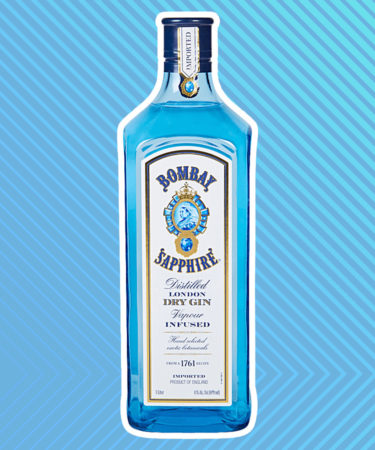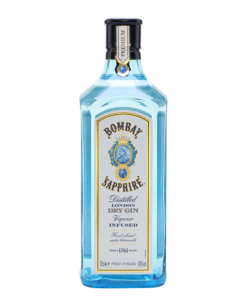
There’s a lot more a lot of us should know about gin in general. Which means there’s definitely plenty we should know about a gin like Bombay Sapphire.
The great grandchild of the 1761 gin distillery founded by Thomas Dakin in Warrington, England, Bombay burst onto the scene in the late ‘80s. At a time when the rest of us were making really, really bad hair decisions, Bombay took branding and production in an entirely new direction. It may never be enough to convert the juniper haters (will there ever be peace?), but Bombay did pave the way for the bevvy of artisanal, craft, garden-patch-in-a-glass gins we know and love and thoughtfully ponder today.
Here are 11 things you should know about Bombay Sapphire gin.
There Is an Actual Bombay Sapphire and You Can’t Have It.
A bottle of Bombay Sapphire will run you about $30. You’ll have to pay a bit more for the Star of Bombay, the big beautiful blue rock that inspired both the gin’s name and its crystalline blue bottle. Originally from Sri Lanka, the 182-megawatt gem was a gift to pioneering Hollywood powerhouse Mary Pickford (producer, co-founder of United Artists, and hair extension-wearing Tinsel Town bad ass).
It’s a London Dry Gin, But You Could Make It in Jersey.
You can make bourbon outside of Kentucky, and London Dry gin doesn’t have to be made in London. Gotta love the rules of alcohol production. Bombay Sapphire is a London Dry gin, but that’s not a regional designation (like Bordeaux or Scotch whisky). It’s a style — specifically, a dry style of gin that doesn’t use any artificial ingredients. Instead, distillers balance piney juniper notes with a dealer’s choice of botanicals and spices.
Bombay Got Botanical on Everyone’s Ass.
The dour-looking Queen Victoria on the label might make it seem old-school, but Bombay Sapphire only entered the market in 1987, pitting it against London Dry megaliths like Beefeater and Tanqueray. To differentiate the brand, none other than Absolut Vodka savior Michel Roux came up with a revolutionary marketing campaign. His plan: make a big fuss about the botanicals. Rather than shroud them in an air of mystery like the Colonel’s 11 herbs and spices (seriously, guy, just tell us), the campaign put Bombay’s botanicals front and center — decades before “artisanal” spirits began writing haikus about the farms where their grains are grown. Today, Bombay’s master of botanicals Ivano Tonutti safeguards the recipe.
Steeping Is for Suckers. Bombay Steams.
Gin is distilled a lot like vodka, except in gin’s case, the resulting neutral spirit is infused with the aforementioned botanical bouquet. Typically the botanicals steep in the spirit like tea leaves, but Bombay actually cradles them in the copper basket of what’s called a Carterhead still (which kind of looks like Tick Tock from “Return to Oz”). The distilled spirit steams through the botanicals, the goal being a more delicate flavor profile.
The Botanicals Leapfrog From Body Wash to Booze.
Bombay Sapphire’s 10 botanicals include some usual suspects (juniper, cassia bark, liquorice, citrus) and some lesser-known characters (Moroccan cubeb berries, kind of like a cross between allspice and peppercorns). But if you want to dig even deeper, check out chemist John Emsley’s analysis of the Bombay botanicals for Wired. Some fun facts: Liquorice contains a molecule that’s 30 times sweeter than sugar, and you might find coriander in your shower gel.
One Time They Flubbed the ABV. Hard.
Back in 2017, a few Canadian provinces got way too much booze for their buck. Sounds like a good problem, except the mis-produced bottles of Bombay had a whopping (i.e., physically dangerous) 77 percent ABV instead of the labeled 40 percent. Apparently they’d missed that critical dilution step. There was a recall, of course, hopefully before anyone made any significant tattoo decisions.
Danny Zuko and Ziggy Stardust Are Fans.
None other than John Travolta and the late, great David Bowie both counted a Bombay Sapphire Martini among their favorite drinks. We can’t imagine a slicker, sexier endorsement.
Awwww. Bombay Names Its Stills!
Who says liquor brands aren’t sentimental? When the brand launched in 1987, Bombay’s original Carterhead stills were called Tom and Mary. The company has grown considerably since then (by 2000, Bombay produced 1 million 9-liter cases), necessitating the addition of two new 12,000-liter copper pot stills, affectionately called Henry and Victoria. There might be more still-naming to come: The company hit 3.8 million 9-liter cases in 2016.
They’re O.G. but They’re Also on Trend.
The gin category, as we’ve seen, isn’t as simple as juniper plus booze. Beyond London Dry versus Old Tom versus Navy Strength etc., gin brands are diversifying internally, and Bombay’s clearly pumped about it. In 2014 the company rolled out a 47 percent ABV, spice-jacked, vermouth-barrel-aged Bombay Amber. It also added lemongrass and Vietnamese peppercorns to create Bombay East. And in 2016 it added Italian Bergamot and floral Ecuadorian ambrette seeds to Bombay Sapphire to create the ultra-super-premium “Star of Bombay,” a “slow single batch” gin intended exclusively for a globe-hopping international market.
There is a Literary Journal Named After It.
The Jack Kerouac “School of Disembodied Poetics” is part of the Buddhist-inspired, non-sectarian Naropa University in Boulder, Colo. (which actually looks like a really chill place to go to college), and its literary journal — co-founded by Allen Ginsberg — is called Bombay Gin, for reasons we don’t presume to understand but can probably definitely guess.
They Made a Tonic App.
Drinking and technology tend to collide one of two ways: You either join an online wine club and receive monthly bottles of smartly chosen wines, or you drink too much Fireball and go on a regrettable Instagram spree. Bombay Sapphire’s taking the tech-tipple relationship a step further with an app that helps you design your own custom tonic. Before you download it, be forewarned: the questionnaire takes 45 minutes. Then again, assuming you complete it, in three weeks’ time you’ll get a mail order of tonic custom-made to your specific tastes, hopes, dreams, and desires. Just don’t forget to add gin.

